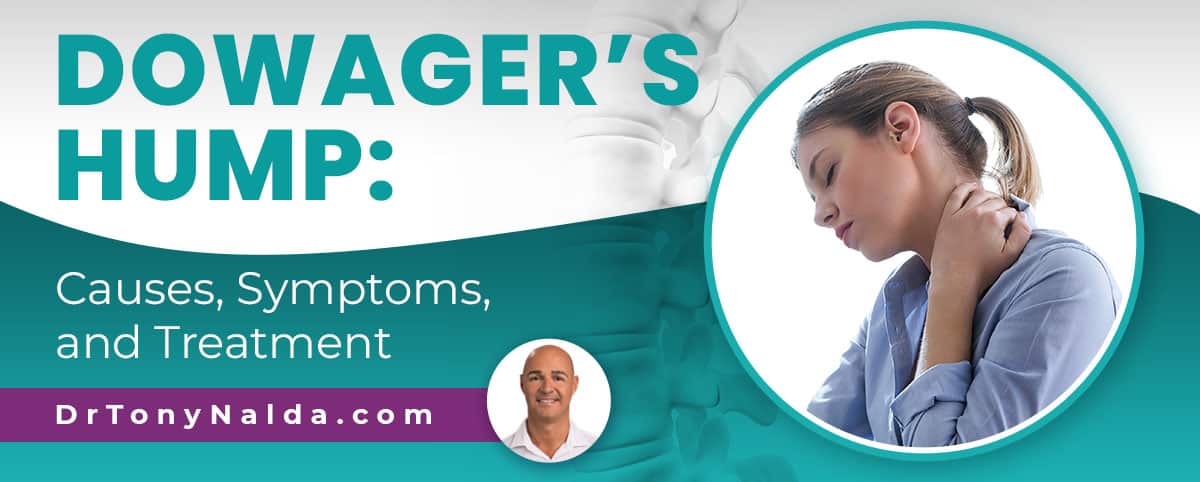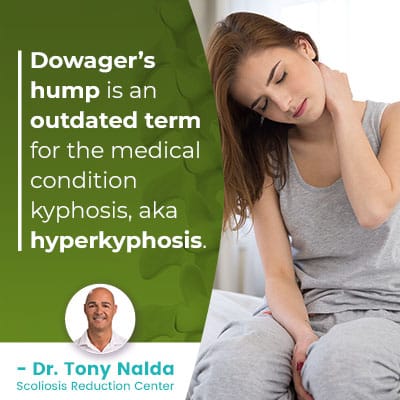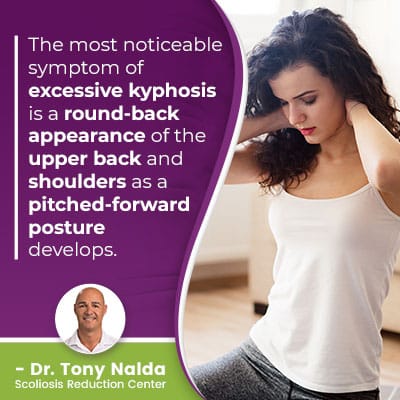Dowager's Hump: Causes, Symptoms, and Treatment

The spine’s natural curves in each of its main sections have a natural size range, but when a curvature degree falls beyond a normal range, problems can occur. When the spine loses one or more of its healthy curves, the biomechanics of the entire spine is disrupted. Continue reading to learn more about dowager's hump causes, symptoms, and treatment options.
The term Dowager’s Hump is an outdated term for the medical condition: kyphosis, aka hyperkyphosis. A kyphotic curve bends outwards, away from the body’s center, in a reverse ‘C’ shape, and can become excessive and cause a number of symptoms.
Before getting to the specifics of kyphosis, let’s first talk about the difference between healthy and unhealthy spinal curves.
Table of Contents
Healthy and Unhealthy Spinal Curves
A healthy spine will appear straight when viewed from the front or back, and will take on a soft ‘S’ shape when viewed from the sides; this is due to the spine’s healthy curves.
The spine’s natural curves make it stronger, more flexible, and better able to absorb and distribute mechanical stress incurred during movement: functioning like a coiled spring.
In order for the spine to function optimally, the spine has to maintain its natural curves and alignment, and the health of each spinal section is dependent upon the health of the others.
The spine is made up of vertebrae (bones of the spine) stacked on top of one another in a straight and neutral alignment and separated by intervertebral discs.
The spine has three main sections: cervical (neck), thoracic (middle/upper back), and lumbar (lower back).
At each of the spine’s main sections, the spine has a characteristic curvature type. While curvature degrees can vary from person to person, as long as those curvature degrees fall within a healthy range, spinal biomechanics are preserved. Still, if a curvature falls beyond a normal range, problems can occur.
The two main types of spinal curves are known as lordosis and kyphosis.
Lordosis and Kyphosis
The cervical and lumbar sections of the spine feature lordotic curves that bend inwards, in a standard ‘C’ shape, and the thoracic spine features a kyphotic curve that bends outwards, away from the body’s center, in a reverse ‘C’ shape.
As mentioned, there are natural ranges of curvature size, and in a healthy spine, a natural range of lordosis at the cervical section would fall within a range of between 20 and 40 degrees, and a normal range of lumbar lordosis would fall between 40 and 60 degrees.
A normal range of thoracic kyphosis would fall within a range of between 20 and 40 degrees.
When a person’s thoracic kyphosis becomes excessive at 50+ degrees, this is diagnosed as excessive kyphosis, aka hyperkyphosis, known in the past as dowager’s hump.
 What is a Dowager’s Hump?
What is a Dowager’s Hump?
Dowager’s hump is an outdated term for the medical condition kyphosis, aka hyperkyphosis.
When a person develops an excessive kyphotic curve in the thoracic spine (middle/upper back), the upper back and shoulder area can become excessively rounded forward, giving the appearance of an arch in the back, known as a hump in the past.
Dowager’s Hump Diagnosis
The symptoms that most often lead to a dowager’s hump diagnosis are postural changes and back/radicular pain.
A physical exam involves taking the patient’s history, particularly regarding spinal conditions, and observing a patient’s posture and gait; I can tell a lot about a patient’s condition by how they walk.
Excessive kyphosis is diagnosed at 50+ degrees, and this is determined via X-ray by measuring the degree of thoracic kyphosis; remember, a natural range would fall within 20 to 40 degrees.
So if a diagnosis of excessive kyphosis is given, what types of causes are associated with the condition?
Dowager’s Hump Causes and Treatment
Excessive kyphosis has different causes, depending on the type in question. There are three main types of kyphosis: postural, congenital, and Scheuermann’s.
Postural Kyphosis is caused by chronic poor posture and is the most common type and the simplest to treat; chronic poor posture can put pressure on vertebrae that changes their position over time.
Postural kyphosis is not structural, meaning it’s not caused by a structural abnormality within the spine, so a change in position can change the spine’s level of kyphosis.
Also known as tech neck, forward head posture can develop due to constantly looking down at devices; this increases the weight of the head on the neck, straining the neck and surrounding muscles, and this can also contribute to the development of excessive kyphosis.
Obesity also is a common contributing factor associated with the development of postural kyphosis, as the extra weight on the joints can weaken the spine’s structure over time and strain the spine.
As a non-structural condition, postural kyphosis can be treated with lifestyle modification/guidance and physical therapy to improve posture.
Congenital kyphosis is a structural condition that develops in utero due to a malformation within the spine itself; when vertebrae are misshapen, they can’t be aligned properly with the rest of the spine, and the spine can become excessively curved and rounded.
Treatment for congenital kyphosis is complex and requires modifications to account for the unique challenges of treating such a young age group; a key component of treatment is closely monitoring children for progression.
While bracing can be effective in some cases of congenital kyphosis, patients sometimes receive surgical recommendations.
Scheuermann’s kyphosis is also structural in nature, so it is complex to treat, often involving one or more vertebrae having a defect where the fronts don’t grow as fast as the backs, which makes them more triangular in shape.
The rectangular-shaped vertebrae become wedged together and push forward, causing the thoracic spine to shift forward in position and cause the characteristic round back appearance.
While treatment needs will be case-specific, Scheuermann’s kyphosis can be treated with a combination of condition-specific treatment disciplines: chiropractic care, physical therapy, and corrective bracing.
Chiropractic care can work towards adjusting the most-tilted vertebrae of the curve back into alignment with the rest of the spine.
As the spine’s natural curves are restored, its biomechanics are improved, along with overall spinal health and function.
A variety of physical therapy exercises and stretches can help strengthen the spine and its surrounding muscles so the spine can be optimally supported and stabilized by its surrounding muscles.
When necessary, corrective bracing can help augment corrective results achieved through other forms of treatment by pushing the spine into a corrective position and preventing further progression.
 Dowager’s Hump Symptoms
Dowager’s Hump Symptoms
The most noticeable symptom of excessive kyphosis is a round-back appearance of the upper back and shoulders as a pitched-forward posture develops.
Spinal conditions can affect the body in a number of ways because the spine and brain work in tandem to form the central nervous system (CNS): a complex network of nerves that facilitate brain-body communication.
There are 31 pairs of spinal nerves, with each pair connecting the spinal cord to a different section of the body.
When the spine develops an unnatural spinal curve, it can affect nerve health and function, and in addition to a round back appearance, depending on the degree of nerve involvement, symptoms of excessive kyphosis can include:
- Numbness in the legs and feet
- Tingling in the legs and fee
- Fatigue
- Issues with balance
- Issues with coordination
- Lung impairment
- Bladder/bowel issues
Symptoms will vary from one patient to the next and depend on key factors such as patient age and overall health, causation, and severity.
Conclusion
While dowager’s hump is an outdated term for excessive kyphosis, aka hyperkyphosis, the spinal condition causes a forward-rounding of the upper back and shoulders, commonly referred to as round back.
Multiple kinds of dowager’s humps have their own associated causes; the most common are postural, congenital, and Scheuermann’s kyphosis.
Symptoms of dowager’s hump will depend on the degree of nerve involvement and can include radicular pain, tingling, or numbness felt in different areas of the body.
Neck and back pain are common symptoms of excessive kyphosis, in addition to the characteristic round-back appearance.
In severe cases, or if left untreated or not treated proactively, symptom severity can increase and cause complications such as bowel and bladder issues, balance and coordination impairment, and lung impairment.
Here at the Scoliosis Reduction Center, I’ve treated a wide range of spinal conditions, both structural and nonstructural, dowager’s hump included.
In cases of structural kyphosis, as in congenital and Scheuermann’s, treatment is more complex and has to impact the condition on a structural level. First and foremost, this is achieved through condition-specific chiropractic care.
Through a variety of physical therapy exercises, I can also help patients work towards increasing core strength, so the spine is optimally supported by its surrounding muscles.
Once a condition’s underlying cause is determined, effective customized treatment plans can be shaped around key patient/condition variables.
Dr. Tony Nalda
DOCTOR OF CHIROPRACTIC
After receiving an undergraduate degree in psychology and his Doctorate of Chiropractic from Life University, Dr. Nalda settled in Celebration, Florida and proceeded to build one of Central Florida’s most successful chiropractic clinics.
His experience with patients suffering from scoliosis, and the confusion and frustration they faced, led him to seek a specialty in scoliosis care. In 2006 he completed his Intensive Care Certification from CLEAR Institute, a leading scoliosis educational and certification center.
About Dr. Tony Nalda
 Ready to explore scoliosis treatment? Contact Us Now
Ready to explore scoliosis treatment? Contact Us Now





